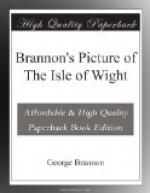* * * * *
The earthy precipices between Shanklin and Luccombe Chines are called DUNNOSE,—they form the southern termination of Sandown Bay, which is a beautiful stretch of shore of above five miles in extent, bounded on the north by the white cliffs of Bembridge.
* * * * *
As we pursue our tour we can trace the course of the Chine (above the head), by the freshness and luxuriant growth of the trees that stand on its narrow banks: and just as we approximate the little parish-church, pass over a bridge thrown across it—but the streamlet itself is almost hidden by wild brushwood and aquatic weeds. The spring-head is a little above the church.
[Illustration: SHANKLIN CHURCH, I.W. And the Road leading to Luccombe & the Undercliff]
The Plate represents the church, and a remarkable portion of the road on quitting the village for the back of the island; it is seen ascending circuitously the side of a steep down, between a hanging copse and several groups of the finest ash trees,—one of which (on the left-hand,) has long been celebrated for its amplitude and beauty.
It is quite impossible for language to convey more than a faint idea of the magnificent and interesting prospect which gradually opens to view as the traveller ascends the mountain ridge: the British Channel spreads its blue waters as the boundary on the one side; the greatest portion of the island recedes in the most charming gradations on the other: and the Solent Channel presents the animated appearance of a noble river, crowded with ships of every description; while the opposite coast of Hampshire and Sussex may be traced more or less distinctly for 70 or 80 miles.
* * * * *
A series of pasturing downs stretch for several miles nearly parallel with the sea-coast: of these the nearest is Shanklin—its northern slope being abruptly broken by a fine range of cliff, composed chiefly of gray free-stone feathered by hanging woods, and on the edge of this beautiful precipice stand some very picturesque ruins called ...
COOKE’s CASTLE,
[Illustration: COOKE’s CASTLE. An ancient ruin on the Appuldurcombe Estate—Isle of Wight.]
Which being seen from a considerable distance in various directions, and never before published, appeared to the Artist to well merit a sketch. Sir Richard Worsley, in his History of the Isle of Wight, states it to be the “ruin of an ancient castle” (though it has been said that it was built as an object of view from Appuldurcombe House); but whether artificial, or really a relic of antiquity, is of little importance, while it proves so conspicuous an ornament to the scene.
* * * * *
LUCCOMBE CHINE
Is another chasm in the sea-cliffs, similar to Shanklin in its character, but on a very inferior scale: and therefore is seldom visited by those in a vehicle who have little time to spare. But many walk from Shanklin to it, either on the beach (if the tide be ebbing), or by a foot-path near the edge of the cliffs, the distance being about two miles: either way is extremely pleasant. A few houses and cottages scattered about, serve to enliven the scene.




